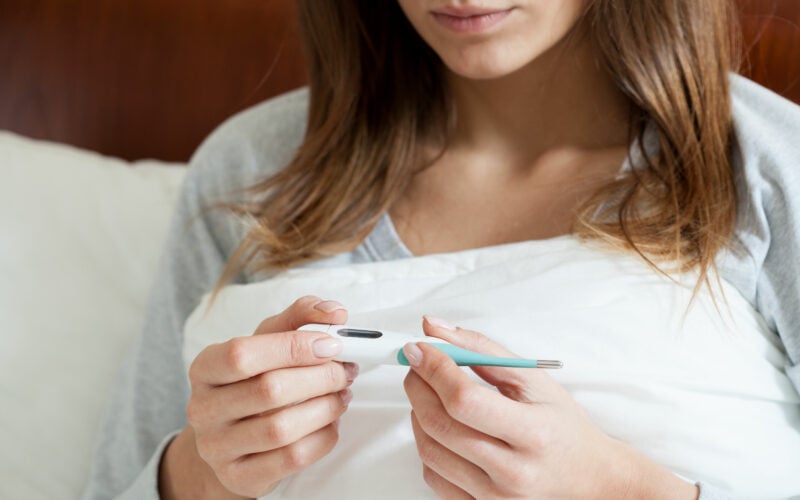Have you ever had a friend who was trying to get pregnant say they’ve been “taking their temperature” to aid their efforts to conceive? Maybe you’ve wondered what on earth your temperature could have to do with fertility. After all, what could your temperature possibly tell you other than whether you’re sick or not? As it turns out, quite a lot! But here’s the clincher: it needs to be a specific kind of temperature, known as your basal body temperature.
Even if you’re brand-new to the world of fertility awareness—a natural form of family planning that can be used to both prevent or achieve pregnancy—you may have already come across the words ‘basal body temperature.’ Maybe you’ve read about ‘basal body temperature’ with other potentially unfamiliar terms or names like Sensiplan, SymptoPro, symptothermal method, or something called the Couple to Couple League. Here’s a brief overview of what basal body temperature is, and what you need to know about basal body temperature in the context of its use in fertility awareness.
What is Basal Body Temperature, and how do you check it?
Basal body temperature (BBT) refers to your lowest body temperature each day which occurs “at complete rest,” according to the Cleveland Clinic. BBT is measured first thing after waking up every day, ideally before you even get out of bed or do anything else. BBT can be measured with an oral, vaginal, or rectal thermometer, but whichever route you choose should be the way you measure BBT each day. You would not, for instance, check vaginal temperatures half the time and oral temperatures the other half. Taking your temperature under your underarm yields unreliable results and is not recommended.
If you work night shifts or swing shifts, your basal body temperature should be measured after your longest period of uninterrupted sleep, and within an hour of the same time every day. If you’re a night shift worker and tend to wake up around 3pm, you would need to set your alarm to wake up at 3pm each day in order for the readings to be accurate.
How BBT can be used to track your cycle and confirm ovulation
Women track BBT to identify ovulation, as ovulation correlates with a significant rise in BBT. A woman’s body temperature tends to be reliably lower during the first half of her cycle (before ovulation), with a noticeable upward shift occurring around the middle of the cycle (ovulation), and remaining reliably higher until her period starts (and a new cycle begins). As a woman tracks her basal body temperatures month after month, she will learn what her unique body’s “normal” high and low temperature levels look like.
The reason for the noticeable shift in BBT between the first half of the cycle and the second half, is because BBT is responsive to the cyclic rise and fall of estrogen and progesterone that occurs over the course of a woman’s menstrual cycle. Before ovulation, when estrogen levels are high (and progesterone is low), the BBT will be low. The average woman’s basal body temperature at this time tends to range from 97° F to 97.5° F. Sometimes, when estrogen levels are highest just before ovulation, a woman may see her BBT dip slightly (although not every woman may see this pre-ovulation dip, every time).
The release of an egg during ovulation causes progesterone to rise, and a corresponding spike in a woman’s BBT. Because ovulation itself causes the temperature rise, ovulation can only be confirmed via BBT readings retroactively, or after it’s already happened–in other words, you cannot use BBT tracking to predict ovulation. As estrogen levels decrease (and remain low) and progesterone levels increase (and remain high) during the second half of the cycle after ovulation has occurred, the BBT will remain elevated until a woman’s next period begins (unless she has gotten pregnant that cycle, in which case her BBT will remain elevated far beyond when her next period was expected to start). The average woman’s post-ovulatory temperature tends to be between 97.6° F and 98.6° F.
Which FAMs want you to track your BBT?
Several methods of fertility awareness require you to track your basal body temperature. Methods in the “symptothermal” family of FAMs utilize cervical mucus observations (sympto) together with BBT readings (thermal). Couples who want to get pregnant would be sure to have sex during a woman’s fertile window, which can be identified by changes in cervical mucus observations as well as temperature changes. Couples seeking to avoid pregnancy would avoid sex during the fertile window, which would conclude three days after ovulation as identified by mucus changes and temperature changes. Members of the symptothermal method family are Sensiplan, SymptoPro, and the Couple to Couple League.
The Natural Cycles App is not a true symptothermal method of natural family planning, because while it requires BBT readings and cycle length input, it does not require documentation of other primary fertility signs such as cervical mucus observations. It also recommends the use of condoms during the fertile window, which is counter to what most methods of FAM or NFP teach, as condoms can negatively impact how effective a FAM is at preventing pregnancy.
How effective are fertility awareness methods for avoiding pregnancy?
Effectiveness rates for pregnancy prevention are very high for the family of symptothermal methods. Perfect use failure rates can be as low as 0-2%. From the website for the American version of Sensiplan, Sensiplan is “an evidence-based, peer-reviewed method of family planning developed over a period of decades in Germany” and is “the method with the greatest number of research studies and highest effectiveness for avoiding pregnancy.” According to a 2018 meta-analysis of FAMs summarized by Natural Womanhood in the table below, Sensiplan’s typical use effectiveness rate is 98%, which is superior to most forms of pharmaceutical birth control.
SymptoPro and Couple to Couple League have less research done on them, but their perfect use and typical use effectiveness rates should be similar to Sensiplan given that the rules for use are very nearly the same for all three.
The Natural Cycles app has 93% pregnancy prevention effectiveness with typical use according to its website, and 90% pregnancy prevention effectiveness according to the meta-analysis cited above.
Source: Unpacking the CDC’s numbers on fertility awareness | Natural Womanhood
What can make BBT readings unreliable or tricky to track?
Reliable BBT data requires that daily readings be taken around the same time of day, every day, and always first thing after waking up. While there is a little bit of wiggle room within those parameters (e.g., one morning you got out of bed to pee when you woke up, and then immediately took your temperature, or you slept in for an additional 30 minutes on Saturday, and then took your temp) taking BBT measurements too far outside of those parameters can make the readings unreliable and therefore unusable—especially for couples seeking to successfully avoid pregnancy.
BBT readings can also be affected by overconsumption of alcohol the night before, fever due to illness, stress, and travel. Women who work continually changing shifts may also find it difficult to consistently track their temperatures.
Furthermore, FAMs utilizing BBT may be less effective for pregnancy avoidance in women with hypothyroidism (under-functioning thyroid), who will consistently have low BBT readings, or with hyperthyroidism (over-functioning thyroid), who will consistently have elevated BBT readings.
What about bracelets and rings that track skin temperature?
In recent years, the growing market of femtech products has come up with some creative ways to take the guesswork out of temperature tracking. From devices like the TempDrop, to the Ava bracelet, to the Oura ring, wearable devices and jewelry which monitor a woman’s BBT are revolutionizing the way women monitor certain fertility biomarkers.
According to a 2020 article from the Fertility Appreciation Collaborative to Teach the Science (FACTS), research from 2018 suggests that wrist skin temperature (WST) readings as tracked with a wrist wearable like the Ava bracelet reliably mimicked BBT readings. FACTS concluded that wrist skin measurement “appears to be robust to confounding factors that influence traditional BBT readings. Thus, measuring nightly WST using a wearable device may serve as a more convenient and environmentally stable alternative to traditional BBT methods for fertility tracking, especially if used in conjunction with biological markers denoting the start of the fertile window and/or ovulation.”
How do I start tracking my BBT for achieving pregnancy or for pregnancy prevention?
If you want to learn more about basal body temperature and how to track it for pregnancy prevention or achievement, your best bet is to learn a symptothermal fertility awareness method (FAM) from a trained instructor. If you’re serious about learning and successfully using a FAM, the trained instructor component is key. Learning about BBT so that you know what it is (and why it is an essential component of fertility awareness), is an important very first step. Having an instructor, though, bridges the gap between reading an article, book, etc., and making accurate observations of what’s happening in your own body, especially if you’re using that information to avoid or achieve a pregnancy.
Congrats on taking this important first step. Read more below to keep going!
Additional Reading:
FAM Basics: What is Cervical Mucus?
Interview with Dr. Elina Berglund, founder of the FDA-approved Natural Cycles app
Unpacking the effectiveness range of FAMs given by the CDC
This Chart “Perfectly” Displays Perfect vs. Typical Use Effectiveness Rate for Birth Control Methods
CDC Changes Effectiveness Rating on Fertility Awareness Methods











